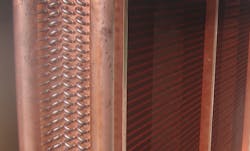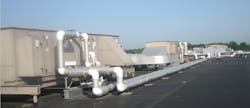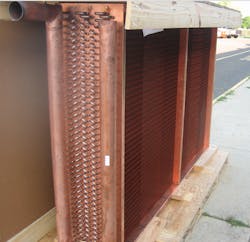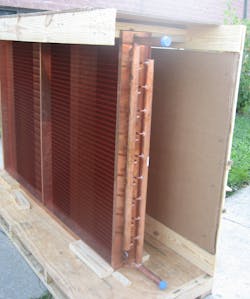All-Copper Coils Found to Resist Bio-Fouling in Rooftop AHU’s
By DALE POWELL, Copper Development Association, and JOHN HIPCHEN, Exel Consulting Group
Rooftop air handling units (AHUs) typically include coils made from copper tubes and aluminum fins. Ultraviolet germicidal irradiation (UVGI) is commonly used to control bio-growth and prevent fouling of the coils. Concerns about surfaces outside of the radiation field, as well as about energy costs and maintenance issues related to UVGI equipment, have led to a search for better methods and materials.
Recently, a study was undertaken to compare the current state-of-the-art copper-tube/aluminum-fin coils to coils made entirely of copper alloy. The Copper Development Association commissioned a study on the use of all copper coils in air handling units to reduce biofouling and extend the life of the heat exchanger coils [1].
The study took place at a New Jersey school that was fitted with seven rooftop AHU’s. This building was chosen because it was large enough to allow for a side-by-side comparison of similar AHU’s, including conventional coils, coils protected with UVGI, and all-copper coils. The building was in a climate region that includes cooling and heating seasons. Built in the late 1980s, the 100,000-plus-sq-ft school underwent a complete HVAC system renovation in 2005.
Three AHUs were involved in this study. While they were equal in size, they also possessed the following important differences:
- AHU-4 had conventional coils made from with copper tubes, aluminum fins, aluminum brackets and aluminum drip pans. Additionally, AHU-4 was equipped with an ultraviolet germicidal irradiation (UVGI) system;
- AHU-5 was retrofitted with coils made with copper tubes, copper fins as well as copper brackets and drip pans;
- AHU-6 had conventional coils made from with copper tubes, aluminum fins, aluminum brackets and aluminum drip pans, with no UVGI system.
Swabs were taken to measure the bio-growth on the surfaces of fins on both the supply-side and discharge-side of the coils, as well as the surfaces of drip pans. Measurements were made for a full heating and cooling season. Significantly more bio-growth was measured on AHU-4 and AHU-6, compared to AHU-5, suggesting that all-copper coils are a highly effective means of controlling the biofouling of heat exchangers.
Independent Heating and Cooling Coils
The school spaces are conditioned through the use of seven large rooftop units. Each rooftop unit contains an independent hot water coil and a chilled water coil. Although the heating and cooling coils run independently, the conditioned air passes through both coils. The units draw both return air from the conditioned space as well as outside air. Air runs through pre-filters and then passes through high-efficiency particulate air (HEPA) filtration prior to passing through the heating and cooling coil. Then the air is discharged into the ductwork mains for distribution throughout the school. Units also contain UV lights for bacteria disinfection. Pre-filters are changed quarterly and the HEPA filters are changed annually.
The HVAC system is controlled by requiring 55ºF (12.8ºC) discharge air from the rooftop units, ensuring sufficient heat during the heating season and sufficient dehumidification and cooling during the cooling season.
Antimicrobial Properties
The antimicrobial properties of copper are well documented in the technical literature (Weaver, et al, 2010). More than 500 copper alloys have been registered with the U.S. Environmental Protection Agency as antimicrobial agents for touch surfaces.
EPA granted a “Treated Article Exemption” registration for copper alloys used in HVAC applications. The Treated Article Exemption allows registered manufacturers of copper HVAC components to make product protection claims of suppressed growth of bacteria, mold and mildew that can reduce system efficiency, accelerate product deterioration and cause foul odors.
The school building study was designed to explore the effectiveness of antimicrobial copper alloys in the prevention of bio-growth on commercial cooling and heating coils, including coil support structures such as brackets and drain pans. The main objectives were to compare conventional aluminum-fin coils to copper-fin coils side-by-side in real world applications; and to compare the effects of UVGI on bio-growth with the inherent antimicrobial properties of copper.
During the study, samples of air were taken, as well as samples from the surfaces of the heating coils and cooling coils. Locations included vertical surfaces as well as low-lying crevice surfaces. The coil samples were tested for fungal and bacterial colonies. Air samples were tested for fungal structures only. Detailed species analyses were not in the scope of this study.
Energy Efficiency and Micro-Organisms
The growth of molds and other bio-organisms on heat exchangers in commercial AHUs can reduce air flow, thereby affecting the efficiency of the HVAC system. These same molds and micro-organisms affect air quality, as well. Bio-growth was found to be especially prevalent on the moist surfaces of the cooling coils.
Using UVGI to control bio-growth on heat exchange coils in commercial AHU’s has become a common practice. UVGI is effective on surfaces that receive sufficient doses of radiation, but there are concerns about surfaces outside of the radiation field. Furthermore, concerns about energy costs and maintenance issues related to UVGI equipment has led to a search for new methods and materials that are more effective and less costly in reducing bio-fouling of heat exchange coils over the life of an AHU.
Bio-Growth Swab Results
Samples from the coils included the upstream or supply-side of the coil and the downstream or discharge-side of the coil. The sampling locations focused on vertical surfaces and low lying crevice surfaces. Each sample was tested for fungi and bacteria using the culture method. Detailed tables of results can be found in the Purdue publication [1]. No appreciable bio-growth was recorded on any of the heating coils. Therefore, heating coil fungal and bacterial data was omitted from the data tables in the Purdue publication.
The data shows fungal and bacterial concentrations from the initial baseline date followed by three additional dates covering a full cooling season and heating season.
A critical comparison can be made between AHU-4, which includes UVGI and represents the current state-of-the-art, and AHU-5, which represents a potential replacement using copper components without UVGI. Considering fungal data from a full cooling season (April to October), this data shows copper coils without UVGI were more effective at combating bio-growth than conventional coils with UVGI.
Again focusing on data through a full cooling season, data showed significantly lower bacterial colonies in the fin pack of the all-copper cooling coil and dramatically lower bacterial colonies on the flat surfaces.
Bacterial data from the discharge-side of the pan was especially lopsided in favor of copper. In June, samples showed 90,000 colony-forming units (CFU) per square inch existed on AHU-4, compared to 600 CFU for AHU-5; and by October the difference had swelled to 220,000 vs. 100. This is possibly due to the minimal amount of UV light that is able to penetrate through the aluminum fin pack to irradiate this surface.
The Copper Advantage
This study indicates that due to the inherent antimicrobial properties of copper, cooling and heating coils made from copper will control bio-growth without the use of additional agents such as UVGI. The potential benefits of coils made entirely from copper alloys include: (1) reduced energy consumption because anti-fouling properties of copper coils help maximize airflow; (2) reduced energy consumption as UVGI equipment is not required; (3) reduced maintenance for coil cleaning; and (4) no maintenance for UVGI equipment.
These results support further research on energy efficiency losses due to coil fouling and reduced airflows, as well as potential improvements in “total cost of ownership” (TCO) from all-copper coils.
Additionally, a project that includes detailed species analyses and studies the effect of all-copper coils on indoor air quality (IAQ) may uncover and quantify benefits of copper HVAC materials that are not fully understood at this time.
References
1. This research was presented at the 2018 Purdue Conferences [1]. Comparison Study of Bio-Growth in Commercial AHU’s Using Copper Heat Exchangers and Components, by John HIPCHEN, Annina HOGAN, and Dale POWELL, Paper 2476.
2. Weaver, L., Keevil C.W., Michels, H.T. (2010). Potential for preventing spread of fungi in air conditioning systems constructed using copper instead of aluminum. Letters in Applied Microbiology. 50, 18-23.
Acknowledgement
Chin S. Yang, Ph.D., Prestige EnviroMicrobiology, Inc., Voorhees, NJ.



